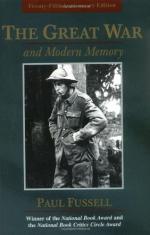
|
| Name: _________________________ | Period: ___________________ |
This test consists of 15 multiple choice questions and 5 short answer questions.
Multiple Choice Questions
1. When soldiers wrote letters home, they were not always _____.
(a) Honest.
(b) All answers are correct.
(c) Respectful when writing about others.
(d) Candid.
2. What colors came to symbolize injury and hospitalization?
(a) Red, white, and green.
(b) Red, white, and blue.
(c) Yellow, red, and green.
(d) Yellow, red, and blue.
3. Who does Fussell refer to as the master of spiritual irony?
(a) George Sherston.
(b) Sir Douglas Haig.
(c) General Sir George Plumer.
(d) Thomas Hardy.
4. What were these trenches called?
(a) German Line.
(b) Line of Belguim.
(c) French ditches.
(d) British Line.
5. Some German trenches included what special features?
(a) Kitchens.
(b) All answers are correct.
(c) Bunk beds.
(d) Electricity.
6. By the end of 1917, Germany had shifted their troops in what direction?
(a) Western Front.
(b) Eastern Front.
(c) Northern Front.
(d) Southern Front.
7. In his writing, Hardy captures the fact he could hear _____ across the Channel?
(a) Bombs.
(b) Explosions.
(c) Airplanes.
(d) Gunfire.
8. What author does Fussell mention in representing the idea of crucifixion?
(a) Robert Nichol.
(b) All answers are correct.
(c) Sigfried Sassoon.
(d) Wilfred Owen.
9. When was the final volume of the trilogy written?
(a) The Great Depression.
(b) Civil War.
(c) World War II.
(d) World War I.
10. Fussell begins by quoting a poem by whom?
(a) Laurence Binyon.
(b) Thomas Hardy.
(c) Walt Whitman.
(d) George Sherston.
11. A rumor of most wars concerns _____.
(a) Officers.
(b) Deserters.
(c) Generals.
(d) Troops.
12. In the third volume of the trilogy, where is Sherston?
(a) Front line of the trenches.
(b) Hospital.
(c) Psychiatric hospital.
(d) A London pub.
13. George Sherston used to carry what as a good luck piece?
(a) A feather.
(b) A pen.
(c) A four leaf clover.
(d) A chunk of fire opal.
14. Fussell mentions that an author writes about the German person in the trenches prior to wartime. Who is it?
(a) Siegfried Sassoon.
(b) George Sherston.
(c) Henry Williams.
(d) George Coppard.
15. What is the title of the second part of the trilogy?
(a) Sherston's Progress.
(b) Memoirs of a Fox-Hunting Man.
(c) Memoirs of an Infantry Officer.
(d) No answers are correct.
Short Answer Questions
1. Altogether, the Sassoon trilogy makes what type of point to the reader?
2. During World War II, where did many soldiers fight from?
3. The last of the volumes of Siegfried Sassoon's works is called _____.
4. According to Fussell, personalities change as people are exposed to _____.
5. In "How Young They Died," a soldier, after two weeks in France, feels how?
|
This section contains 389 words (approx. 2 pages at 300 words per page) |

|




